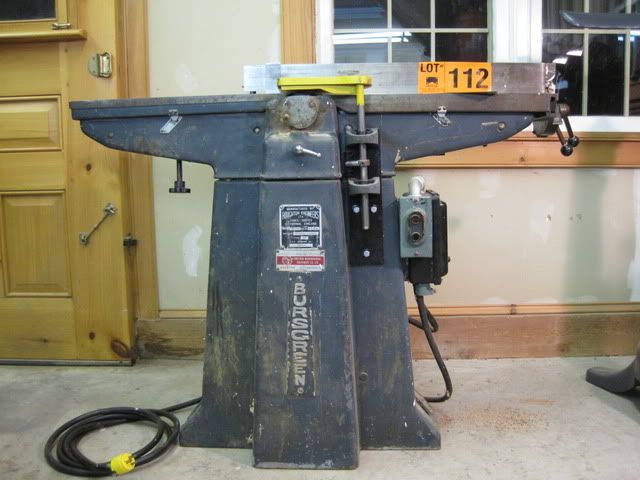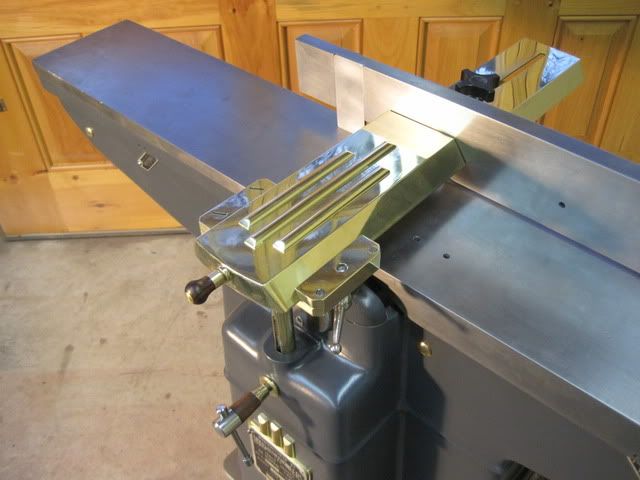tool613
Established Member
Hi boys
as you may know i am from Canada and the pork chop planer guard is king.
The bridge guard comes in two forms. The ones i have seen and used are rigid and
yes when edge jointing you pull it back just the thickness
of the stock being processed. Remember the void is filled up by the
wood when you are working. There is another source for bridge guards, the
Suva guard has a pnuematic lever that allows the guard to remain in place and the lever allows the guard to be pushed out of the way when edge jointing just enough to pass the stock through. It is in my opinion the best possible solution but that also isn't free. They go for 1200+.
The Bridge guard is also raised to allow the passage of the stock when face
jointing and I consider it much safer than the porkchop guard. The porkchop only works when you are not using the machine, otherwise it is
retracted allowing the cutterblock full access to your body.
I REALLY hated the pork chop one came with my Bursgreen and gladly made a bridge guard. I'd never go back now, even with a narrow machine . The Bridge guard is so much easier to use once you get used to it and there is never any exposure from the top of the knives, outside of a thin space the thickness of stock when you are edging.
Just to clarify my statement.. I find the pork chop style guard to be the most dangerous when face jointing, nothing like 10 or 12 inches of exposed knives staring you in the face after passing a board over the jointer.
I don't think the bridge guard poses any significant problem when face jointing. You raise it just high enough for the board to pass below it. Your hands stay above the guard blade at all times and the guard is wide enough to provide adequate protection from coming into contact with the cutters.
this is the Bursgreen with a shop made pork chop.

this is it with the bridge guard in place.

What are your thoughts on the two types of guards? And please show any guarding you have made.
jack
as you may know i am from Canada and the pork chop planer guard is king.
The bridge guard comes in two forms. The ones i have seen and used are rigid and
yes when edge jointing you pull it back just the thickness
of the stock being processed. Remember the void is filled up by the
wood when you are working. There is another source for bridge guards, the
Suva guard has a pnuematic lever that allows the guard to remain in place and the lever allows the guard to be pushed out of the way when edge jointing just enough to pass the stock through. It is in my opinion the best possible solution but that also isn't free. They go for 1200+.
The Bridge guard is also raised to allow the passage of the stock when face
jointing and I consider it much safer than the porkchop guard. The porkchop only works when you are not using the machine, otherwise it is
retracted allowing the cutterblock full access to your body.
I REALLY hated the pork chop one came with my Bursgreen and gladly made a bridge guard. I'd never go back now, even with a narrow machine . The Bridge guard is so much easier to use once you get used to it and there is never any exposure from the top of the knives, outside of a thin space the thickness of stock when you are edging.
Just to clarify my statement.. I find the pork chop style guard to be the most dangerous when face jointing, nothing like 10 or 12 inches of exposed knives staring you in the face after passing a board over the jointer.
I don't think the bridge guard poses any significant problem when face jointing. You raise it just high enough for the board to pass below it. Your hands stay above the guard blade at all times and the guard is wide enough to provide adequate protection from coming into contact with the cutters.
this is the Bursgreen with a shop made pork chop.

this is it with the bridge guard in place.

What are your thoughts on the two types of guards? And please show any guarding you have made.
jack
































